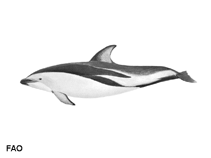Lagenorhynchus obscurus (Gray, 1828)
Dusky dolphin| Native range | All suitable habitat | Point map | Year 2050 |

|
| This map was computer-generated and has not yet been reviewed. |
| Lagenorhynchus obscurus AquaMaps Data sources: GBIF OBIS |
Classification / Names Tên thường gặp | Các synonym ( Các tên trùng) | CoL | ITIS | WoRMS
Mammalia | Cetartiodactyla | Delphinidae
Environment: milieu / climate zone / Mức độ sâu / distribution range Sinh thái học
Tầng nổi. Temperate; 0°N - 90°S, 180°W - 180°E
Distribution Các nước | Các khu vực của FAO | Các hệ sinh thái | Những lần xuất hiện | Những chỉ dẫn
Atlantic Ocean, Indo-Pacific and the Antarctic: Lagenorhynchus obscurus fitzroyi: Peru, Argentina, Falkland Islands, Gough Island; Lagenorhynchus obscurus obscurus: Angola, South Africa, Prince Edward Island, Amsterdam; Lagenorhynchus obscurus subspecies.: New Zealand, Kerguelen, Crozet Island (Ref. 1522).
Length at first maturity / Bộ gần gũi / Weight / Age
Chín muồi sinh dục: Lm ? range ? - ? cm Max length : 210 cm TL con đực/không giới tính; (Tài liệu tham khảo 1394); Khối lượng cực đại được công bố: 80.0 kg (Tài liệu tham khảo 1394)
Life cycle and mating behavior Chín muồi sinh dục | Sự tái sinh sản | Đẻ trứng | Eggs | Sự sinh sản | Larvae
Main reference
Các tài liệu tham khảo | Người điều phối | Người cộng tác
Jefferson, T.A., S. Leatherwood and M.A. Webber 1993 FAO species Identification Guide: Marine Mammals of the World. Rome, FAO. 320 p. + 587 figures. (Tài liệu tham khảo 1394)
IUCN Red List Status
(Tài liệu tham khảo 130435: Version 2025-1)
CITES status (Tài liệu tham khảo 108899)
CMS (Tài liệu tham khảo 116361)
Threat to humans
Human uses
Các nghề cá: Tính thương mại
FAO - Các nghề cá: landings, species profile | FishSource | Biển chung quanh ta
Các công cụ
Thêm thông tin
Max. ages / sizes
Length-weight rel.
Length-length rel.
Length-frequencies
Mass conversion
Sự phong phú
Chín muồi sinh dục
Sự sinh sản
Đẻ trứng
Eggs
Egg development
Larvae
Các nguồn internet
BHL | BOLD Systems | CISTI | DiscoverLife | FAO(Các nghề cá: species profile; publication : search) | Fishipedia | GenBank (genome, nucleotide) | GloBI | Gomexsi | Google Books | Google Scholar | Google | PubMed | Cây Đời sống | Wikipedia (Go, tìm) | Tạp chí Zoological Record



